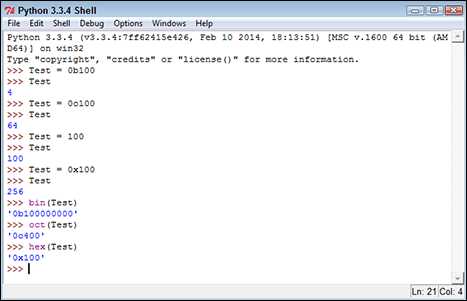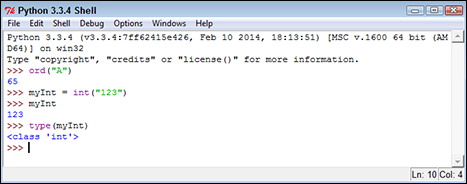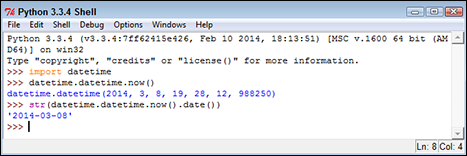Chapter 5
Storing and Modifying Information
In This Chapter
![]() Understanding data storage
Understanding data storage
![]() Considering the kinds of data storage
Considering the kinds of data storage
![]() Adding dates and times to applications
Adding dates and times to applications
Chapter 3 introduces you to CRUD, Create, Read, Update, and Delete — not that Chapter 3 contains cruddy material. This acronym provides an easy method to remember precisely what tasks all computer programs perform with information you want to manage. Of course, geeks use a special term for information — data, but either information or data works fine for this book.
Storing Information
An application requires fast access to information or else it will take a long time to complete tasks. As a result, applications store information in memory. However, memory is temporary. When you turn off the machine, the information must be stored in some permanent form, such as on your hard drive, a Universal Serial Bus (USB) flash drive, or a Secure Digital (SD) card. In addition, you must also consider the form of the information, such as whether it’s a number or text. The following sections discuss the issue of storing information as part of an application in more detail.
Seeing variables as storage boxes
When working with applications, you store information in variables. A variable is a kind of storage box. Whenever you want to work with the information, you access it using the variable. If you have new information you want to store, you put it in a variable. Changing information means accessing the variable first and then storing the new value in the variable. Just as you store things in boxes in the real world, so you store things in variables (a kind of storage box) when working with applications.
Using the right box to store the data
People tend to store things in the wrong sort of box. For example, you might find a pair of shoes in a garment bag and a supply of pens in a shoebox. However, Python likes to be neat. As a result, you find numbers stored in one sort of variable and text stored in an entirely different kind of variable. Yes, you use variables in both cases, but the variable is designed to store a particular kind of information. Using specialized variables makes it possible to work with the information inside in particular ways. You don’t need to worry about the details just yet — just keep in mind that each kind of information is stored in a special kind of variable.
Defining the Essential Python Data Types
Every programming language defines variables that hold specific kinds of information, and Python is no exception. The specific kind of variable is called a data type. Knowing the data type of a variable is important because it tells you what kind of information you find inside. In addition, when you want to store information in a variable, you need a variable of the correct data type to do it. Python doesn’t allow you to store text in a variable designed to hold numeric information. Doing so would damage the text and cause problems with the application. You can generally classify Python data types as numeric, string, and Boolean, although there really isn’t any limit on just how you can view them. The following sections describe each of the standard Python data types within these classifications.
Putting information into variables
To place a value into any variable, you make an assignment using the assignment operator (=). Chapter 6 discusses the whole range of basic Python operators in more detail, but you need to know how to use this particular operator to some extent now. For example, to place the number 5 into a variable named myVar, you type myVar = 5 and press Enter at the Python prompt. Even though Python doesn’t provide any additional information to you, you can always type the variable name and press Enter to see the value it contains, as shown in Figure 5-1.

Figure 5-1: Use the assignment operator to place information into a variable.
Understanding the numeric types
Humans tend to think about numbers in general terms. We view 1 and 1.0 as being the same number — one of them simply has a decimal point. However, as far as we’re concerned, the two numbers are equal and we could easily use them interchangeably. Python views them as being different kinds of numbers because each form requires a different kind of processing. The following sections describe the integer, floating-point, and complex number classes of data types that Python supports.
Integers
Any whole number is an integer. For example, the value 1 is a whole number, so it’s an integer. On the other hand, 1.0 isn’t a whole number; it has a decimal part to it, so it’s not an integer. Integers are represented by the int data type.
When working with the int type, you have access to a number of interesting features. Many of them appear later in the book, but one feature is the ability to use different numeric bases:
- Base 2: Uses only 0 and 1 as numbers.
- Base 8: Uses the numbers 0 through 7.
- Base 10: Uses the usual numeric system.
- Base 16: Is also called hex and uses the numbers 0 through 9 and the letters A through F to create 16 different possible values.
To tell Python when to use bases other than base 10, you add a 0 and a special letter to the number. For example, 0b100 is the value one-zero-zero in base 2. Here are the letters you normally use:
- b: Base 2
- o: Base 8
- x: Base 16
It’s also possible to convert numeric values to other bases using the bin(), oct(), and hex() commands. So, putting everything together, you can see how to convert between bases using the commands shown in Figure 5-2. Try the command shown in the figure yourself so that you can see how the various bases work. Using a different base actually makes things easier in many situations, and you’ll encounter some of those situations later in the book. For now, all you really need to know is that integers support different numeric bases.

Figure 5-2: Integers have many interesting features, including the capability to use different numeric bases.
Floating-point values
Any number that includes a decimal portion is a floating-point value. For example, 1.0 has a decimal part, so it’s a floating-point value. Many people get confused about whole numbers and floating-point numbers, but the difference is easy to remember. If you see a decimal in the number, then it’s a floating-point value. Python stores floating-point values in the float data type.
When working with floating-point values, you can assign the information to the variable in a number of ways. The two most common methods are to provide the number directly and to use scientific notation. When using scientific notation, an e separates the number from its exponent. Figure 5-3 shows both methods of making an assignment. Notice that using a negative exponent results in a fractional value.

Figure 5-3: Floating-point values provide multiple assignment techniques.
Complex numbers
You may or may not remember complex numbers from school. A complex number consists of a real number and an imaginary number that are paired together. Just in case you’ve completely forgotten about complex numbers, you can read about them at http://www.mathsisfun.com/numbers/complex-numbers.html. Real-world uses for complex numbers include:
- Electrical engineering
- Fluid dynamics
- Quantum mechanics
- Computer graphics
- Dynamic systems
Complex numbers have other uses, too, but this list should give you some ideas. In general, if you aren’t involved in any of these disciplines, you probably won’t ever encounter complex numbers. However, Python is one of the few languages that provides a built-in data type to support them. As you progress through the book, you find other ways in which Python lends itself especially well to science and engineering.
The imaginary part of a complex number always appears with a j after it. So, if you want to create a complex number with 3 as the real part and 4 as the imaginary part, you make an assignment like this:
myComplex = 3 + 4j
If you want to see the real part of the variable, you simply type myComplex.real at the Python prompt and press Enter. Likewise, if you want to see the imaginary part of the variable, you type myComplex.imag at the Python prompt and press Enter.
Understanding Boolean values
It may seem amazing, but computers always give you a straight answer! A computer will never provide “maybe” as output. Every answer you get is either True or False. In fact, there is an entire branch of mathematics called Boolean algebra that was originally defined by George Boole (a super-geek of his time) that computers rely upon to make decisions. Contrary to common belief, Boolean algebra has existed since 1854 — long before the time of computers.
When using Boolean value in Python, you rely on the bool type. A variable of this type can contain only two values: True or False. You can assign a value by using the True or False keywords, or you can create an expression that defines a logical idea that equates to true or false. For example, you could say, myBool = 1 > 2, which would equate to False because 1 is most definitely not greater than 2. You see the bool type used extensively in the book, so don’t worry about understanding this concept right now.
Understanding strings
Of all the data types, strings are the most easily understood by humans and not understood at all by computers. If you have read the previous chapters in this book, you have already seen strings used quite. For example, all the example code in Chapter 4 relies on strings. A string is simply any grouping of characters you place within double quotes. For example, myString = "Python is a great language." assigns a string of characters to myString.
The computer doesn’t see letters at all. Every letter you use is represented by a number in memory. For example, the letter A is actually the number 65. To see this for yourself, type ord(“A”) at the Python prompt and press Enter. You see 65 as output. It’s possible to convert any single letter to its numeric equivalent using the ord() command.
Because the computer doesn’t really understand strings, but strings are so useful in writing applications, you sometimes need to convert a string to a number. You can use the int() and float() commands to perform this conversion. For example, if you type myInt = int(“123”) and press Enter at the Python prompt, you create an int named myInt that contains the value 123. Figure 5-4 shows how you can perform this task and validate the content and type of myInt.

Figure 5-4: Converting a string to a number is easy using the int() and float() commands.
You can convert numbers to a string as well by using the str() command. For example, if you type myStr = str(1234.56) and press Enter, you create a string containing the value "1234.56" and assign it to myStr. Figure 5-5 shows this type of conversion and the test you can perform on it. The point is that you can go back and forth between strings and numbers with great ease. Later chapters demonstrate how these conversions make a lot of seemingly impossible tasks quite doable.

Figure 5-5: It’s possible to convert numbers to strings as well.
Working with Dates and Times
Dates and times are items that most people work with quite a bit. Society bases almost everything on the date and time that a task needs to be or was completed. We make appointments and plan events for specific dates and times. Most of our day revolves around the clock. Because of the time-oriented nature of humans, it’s a good idea to look at how Python deals with interacting with dates and time (especially storing these values for later use). As with everything else, computers understand only numbers — the date and time don’t really exist.
Computers do have clocks inside them, but the clocks are for the humans using the computer. Yes, some software also depends on the clock, but again, the emphasis is on human needs rather than anything the computer might require. To get the current time, you can simply type datetime.datetime.now( ) and press Enter. You see the full date and time information as found on your computer’s clock (see Figure 5-6).

Figure 5-6: Get the current date and time using the now() command.
You may have noticed that the date and time are a little hard to read in the existing format. Say that you want to get just the current date, in a readable format. It’s time to combine a few things you discovered in previous sections to accomplish that task. Type str(datetime.datetime.now( ).date( )) and press Enter. Figure 5-7 shows that you now have something a little more usable.

Figure 5-7: Make the date and time more readable using the str() command.
Interestingly enough, Python also has a time() command, which you can use to obtain the current time. You can obtain separate values for each of the components that make up date and time using the day, month, year, hour, minute, second, and microsecond values. Later chapters help you understand how to use these various date and time features to keep application users informed about the current date and time on their system.

 In order to make information useful, you have to have some means of storing it permanently. Otherwise, every time you turned the computer off, all your information would be gone and the computer would provide limited value. In addition, Python must provide some rules for modifying information. The alternative is to have applications running amok, changing information in any and every conceivable manner. This chapter is about controlling information — defining how information is stored permanently and manipulated by applications you create.
In order to make information useful, you have to have some means of storing it permanently. Otherwise, every time you turned the computer off, all your information would be gone and the computer would provide limited value. In addition, Python must provide some rules for modifying information. The alternative is to have applications running amok, changing information in any and every conceivable manner. This chapter is about controlling information — defining how information is stored permanently and manipulated by applications you create. Python uses specialized variables to store information to make things easy for the programmer and to ensure that the information remains safe. However, computers don’t actually know about information types. All that the computer knows about are 0s and 1s, which is the absence or presence of a voltage. At a higher level, computers do work with numbers, but that’s the extent of what computers do. Numbers, letters, dates, times, and any other kind of information you can think about all come down to 0s and 1s in the computer system. For example, the letter A is actually stored as 01000001 or the number 65. The computer has no concept of the letter A or of a date such as 8/31/2014.
Python uses specialized variables to store information to make things easy for the programmer and to ensure that the information remains safe. However, computers don’t actually know about information types. All that the computer knows about are 0s and 1s, which is the absence or presence of a voltage. At a higher level, computers do work with numbers, but that’s the extent of what computers do. Numbers, letters, dates, times, and any other kind of information you can think about all come down to 0s and 1s in the computer system. For example, the letter A is actually stored as 01000001 or the number 65. The computer has no concept of the letter A or of a date such as 8/31/2014.